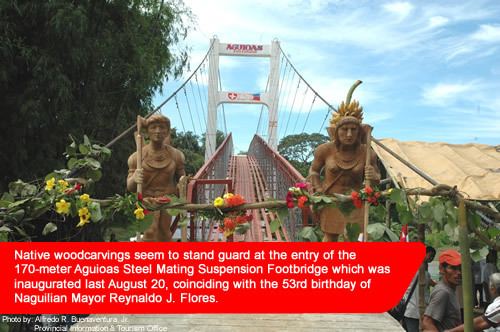Country Philippines Established February 18, 1839 Time zone PST (UTC+8) Population 48,407 (2010) Local time Monday 9:46 AM Dialling code 72 | District 2nd District Barangays Area 104.6 km² Area code 72 Province La Union | |
 | ||
Region Ilocos Region (Region I) Weather 30°C, Wind SW at 5 km/h, 48% Humidity | ||
Naguilian la union
Naguilian is a municipality in the province of La Union, Philippines. According to the 2010 census, it has a population of 49,311 people.
Contents
- Naguilian la union
- Map of Naguilian La Union Philippines
- Geography
- Climate
- Land use
- Adjacent towns and cities
- Agriculture
- Industries
- Commerce
- Fishery
- References
Map of Naguilian, La Union, Philippines
Naguilian is 40 kilometres (25 mi) from Baguio City via the Naguilian Road and 17 kilometres (11 mi) from the provincial capital, San Fernando.
Geography
Naguilian is characterized by hills and mountains that are gently rolling, bordered by the Cordillera Mountains in the east. The alienable lands are rolling plains in narrow strips, framed by the mountains slopes and the banks of rivers, crisscrossed by streams and springs from the side of the mountains. Its soil varies from clay loam to sandy loam and golds.
There are two major rivers in Naguilian. The Naguilian River is located in the western portion of the town. It flows westward beginning from the province of Benguet towards La Union and empties into the South China Sea, draining the valleys of Barangays Bimmotobot, Mamat-ing Sur, Mamat-ing Norte, Tuddingan, Gusing Sur, Gusing Norte, Baraoas Norte, Daramuangan, Dal-lipaoen, Cabaritan Sur, Ortiz, Natividad, Suguidan Norte and Suguidan Sur. It has a length of approximately 67 kilometres (42 mi) and has a basin area of 658 square kilometres (254 sq mi). As classified by the Environmental Management Bureau, the upper reaches of the river falls under Class A which means that it is suitable as water supply source for drinking. The lower reaches has lower water quality, categorized under Class C.
The other major stream springs from the Municipality of Burgos and drains the valleys of Barangays Aguioas, Sili, Al-alinao Norte, Nagsidorisan, Angin, Suguidan Norte and Natividad. These two rivers meet at the poblacion where it forms a delta, then meander through the center of the municipality and empty at the mouth of the river in Bauang.
Climate
The municipality’s climate falls under the first type of climate in the Philippines, characterized by two (2) distinct seasons, wet and dry. The wet season usually comes in May and ends in the early part of October. The rest of the year is dry season.
Land use
Built-up areas of the town are generally spread along the barangay roads. Of the total land area, 50 hectares (120 acres), equivalent to 0.50% of the total land area, are classified as built-up areas. Urban built-up area, totaling 18.90 hectares (46.7 acres), constitute 11.22% of the total urban land area. Rural built-up areas total 31.10 hectares (76.8 acres), or 0.31% of the total rural area.
Through Proclamation No. 52, a portion of Barangay Casilagan, with an area of 897.26 hectares (2,217.2 acres), was proclaimed as a watershed area by the Bureau of Forestry. This is equivalent to .10% of the total land area of the town.
Adjacent towns and cities
Agriculture
Generally, the agricultural lands are narrow strips in the valleys, running from the sides of the mountains to the bank of the rivers, brooks and streams. The rolling areas from the top of the mountains and hills are also utilized for the planting of rice and other crops. The area devoted for agricultural purposes, which totals 9,859.71 hectares (24,363.9 acres) constituting 97% of the total land area.
Industries
Industries in the different parts of the municipality include woodcraft, metal craft, bamboo craft, ceramics or brick making, concrete hollow block making, basi (sugarcane wine) making and furniture making and upholstery, .28% of the total land area of the town is devoted for industrial purposes.
Commerce
The center of commercial activities is the public market located in Barangay Ortiz. There are, however, other commercial establishments found in the different barangays, the most common of which are sari-sari stores. The area devoted for commerce constitutes .03% of the total land area of the town.
Fishery
Fishing is done in almost all barangays traversed by the rivers, namely, Barangays Bimmotobot, Mamat-ing Sur, Mamat-ing Norte, Gusing Norte, Gusing Sur, Baraoas Norte, Baraoas Sur, Ortiz, Cabaritan Norte, Cabaritan Sur, Dal-lipaoen, Nagsidorisan, Suguidan Norte, Suguidan Sur, Guesset, Sili, Al-alinao Norte, Al-alinao Sur, Aguioas and Ribsuan.
